Book contents
- Frontmatter
- Contents
- List of figures
- List of tables
- List of contributors
- Preface and acknowledgments
- Between theory and history: on the identity of Hicks's economics
- Part I The Intellectual Heritage of John Hicks
- Part II Markets
- Part III Money
- Part IV Capital and Dynamics
- 15 ‘Distribution and Economic Progress’ after seventy years
- 16 Flexible saving and economic growth
- 17 The economics of non-linear cycles
- 18 A perspective on a Hicksian non-linear theory of the trade cycle
- 19 Capital, growth, and production disequilibria: on the employment consequences of new technologies
- 20 Capital and time
- 21 Sequential analysis and out-of-equilibrium paths
- References
- Name index
- Subject index
19 - Capital, growth, and production disequilibria: on the employment consequences of new technologies
Published online by Cambridge University Press: 29 June 2009
- Frontmatter
- Contents
- List of figures
- List of tables
- List of contributors
- Preface and acknowledgments
- Between theory and history: on the identity of Hicks's economics
- Part I The Intellectual Heritage of John Hicks
- Part II Markets
- Part III Money
- Part IV Capital and Dynamics
- 15 ‘Distribution and Economic Progress’ after seventy years
- 16 Flexible saving and economic growth
- 17 The economics of non-linear cycles
- 18 A perspective on a Hicksian non-linear theory of the trade cycle
- 19 Capital, growth, and production disequilibria: on the employment consequences of new technologies
- 20 Capital and time
- 21 Sequential analysis and out-of-equilibrium paths
- References
- Name index
- Subject index
Summary
Capital, growth, and unemployment
Throughout his professional life John Hicks maintained a deep interest in capital theory, as is shown by his famous trilogy Value and Capital (1939a), Capital and Growth (1965), and Capital and Time (1973a). In his view, ‘[C]apital … is a very large subject, with many aspects; wherever one starts, it is hard to bring more than a few of them into view’ (1973a: v). In the third volume on capital the unemployment consequences of new technologies are at the very center of Hicks's analysis. Implicit in Capital and Time is the concept of the impulse, which is developed in his 1973 Nobel lecture ‘The Mainspring of Economic Growth’ (1973c), and particularly in the essay on ‘Industrialism’ (1977a: chap. 2). The mainspring of economic progress is invention, which causes an impulse that works its way through the profit mechanism. The investigation of the macroeconomic consequences of such impulses on output and employment is at the focus of the traverse – i.e. the analysis of an economy whose initial equilibrium is disturbed by a change in one of the determinants of growth, such as technical progress. The necessary adjustment path requires both time and costs; in other words, in traverse analysis it is historical time, and no longer logical time, that is decisive.
By the late 1960s Hicks had become fascinated by the Ricardo machinery effect – i.e. the employment consequences of a different, more mechanized method of production.
- Type
- Chapter
- Information
- Markets, Money and CapitalHicksian Economics for the Twenty First Century, pp. 346 - 366Publisher: Cambridge University PressPrint publication year: 2009
- 4
- Cited by



